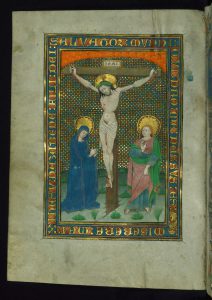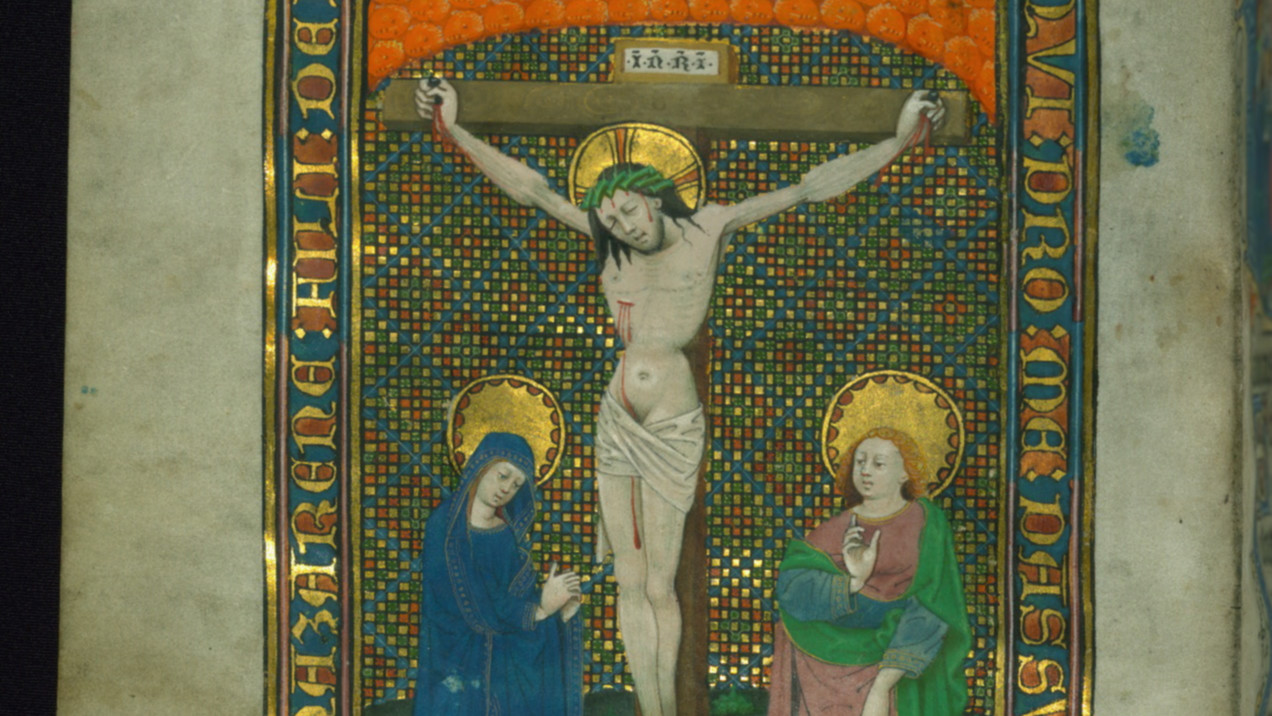By: Emily Walls
The first thing our class did this semester was a “Manuscript Boot Camp” where we spent almost the entirety of the first half of the semester learning the ins and outs of medieval manuscripts, including what they are, how to read and understand them, and how to handle them. This laid the foundation for all the projects we’re doing in the back half of the semester, and it also gave us time to set up a few hard and fast rules about our manuscripts. When we were doing Boot Camp earlier this semester we had a few things impressed on us very quickly; 1) there are no real rules when it comes to medieval manuscripts as a whole, and 2) there is That One Rule. That One Rule is that a Book of Hours cannot be a Book of Hours without containing the Hours of the Virgin, and that anything else is just a prayer book. Therefore, illustrations within Books of Hours are very Mary-centric, and it is almost always the case that within the Hours of the Virgin the illustrations will focus solely on Mary’s life and Christ’s childhood. My chosen Book of Hours, Baltimore, Walters Art Library MS W.172, went in a different direction, and mainly illustrated Christ’s life and Christ’s Passion instead in the form of full-page miniatures that left little doubt to where the focus was going. My question is: Why would a Bo ok of Hours have so much focus on Christ in the Hours of the Virgin, and does it have anything to do with the people who owned it?
ok of Hours have so much focus on Christ in the Hours of the Virgin, and does it have anything to do with the people who owned it?
For clarity’s sake it is important to note that while including Christ imagery in the Hours of the Virgin is highly unusual, it is not completely unheard of. Our textbook for the semester, Introduction to Manuscript Studies, notes that, “While the Hours of the Virgin are very often illustrated with such a sequence focusing on Mary’s life, some Books of Hours have a different sequence with illustrations of the events of Christ’s Passion, from the agony in the Garden of Gethsemane to the entombment” (Clemens and Graham 213). For example, I’ve attached the image, “Crucifixion,” which in Walters MS W.172 is placed at the beginning of the none (the term none refers to an hour within the Book of Hours, and it is a prayer that is recited daily). According to the textbook, the illustration at the beginning of the none would usually be, “the Presentation in the Temple, with Simeon taking the Christ child into his arms” (Clemens and Graham 213). This is very different from what is shown to us in “Crucifixion” in Walters MS W.172, since in “Crucifixion” Mary is literally being placed behind Christ who has been placed in the very center of the full-page miniature.
After finding that illustrations of Christ’s Passion do occasionally show up in Hours of the Virgin my research shifted to finding out why. First we needed background information on where the manuscript came from. The manuscript catalogue tells us that Walters MS W.172 is from a library owned and operated by the Augustinian Canons of Windesheim Chapter ca. 1450, which was located in Zwolle, Netherlands and was founded in 1387 (for a point of reference, this was roughly 36 years after the end of the peak of the Black Plague that devastated Europe). The Windesheim Canons were devotees of a religious practice known as Devotio moderna, also sometimes called the Modern Devotion. The Modern Devotion was characterized by the idea that the, “simple way to God went through the humanity of Jesus Christ, emphasizing the incarnation and passion of the Son of God (“Gerhard Groote and the Devotio Moderna”). Devotees wanted to be as close to Christ as possible, and gain as deep of an understanding as possible of Christ’s sufferings, including his death on the cross. The movement thus focused on things like chastity, humility, obedience, eradicating vices, and celebrating the sanctity of everyday life. Oftentimes this took the form of self-chastisements such as food abstinence or wearing ugly or uncomfortable clothes, or other types of “mortification of the flesh” (Goudriaan 412). The movement had been born ultimately out of a need to reform the church and reign in those members who had strayed and fallen victim to earthly sins such as greed or idleness.
But then how did Walters MS W.172 come into existence? It’s highly possible that it was made by a member of the congregation specifically for their library and usage. In Koen Goudriaan’s article “Empowerment through reading, writing, and example: the Devotio moderna” he tells us that as part of their regular duties, it was common for men of the congregation to write books, acting either as the scribe or as the author, and this was oftentimes done “in order to enrich the house’s library” (Goudriaan 413). It’s this idea that leads me to believe that it was a member of the congregation who wrote out the manuscript and specifically requested that the full-page illustrations be depicting Christ in order to reflect the values of the Modern Devotion movement. The manuscript catalogue tells us that Walters MS W.172 was illuminated by an outside party, the Master of Ghent Privileges and Associates, but the illuminator still would have taken direction from the person or group making the commission.
At this point I’m drawn back to my original question: Why would a Book of Hours have so much focus on Christ in the Hours of the Virgin, and does it have anything to do with the people who owned it? Based upon the information I found it was highly likely that Walters MS W.172 was commissioned by a member of the Windesheim Canons and made specifically for their use; therefore it would have been created specifically in line with their tastes. The emphasis on Christ’s Passion in the Modern Devotion movement is what would have led the Canons to include depictions of the crucifixion and entombment rather than using that space to place illustrations of the Virgin. On one hand the Canons admired Jesus out of an interest to live the way that he lived in an effort to imitate his ethical goodness. On the other hand the Canons also had deeply rooted affective piety, as in a deep emotional attachment, to his death. This intense emphasis on and study of Christ’s Passion deeply affected the Canon’s lives in a way that ultimately led to this variation on the standard presentation of the Hours of the Virgin.
Works Cited
Baltimore, Walters Art Library MS W.172, fol. 38v http://www.thedigitalwalters.org/Data/WaltersManuscripts/W172/data/W.172/sap/W172_000082_sap.jpg
“Books of Hours.” Introduction to Manuscript Studies, by Raymond Clemens and Timothy Graham, Cornell University Press, 2007, pp. 208–221.
Canons of Klosternuburg. Congregations and Houses. 2004, www.augustiniancanons.org/About/houses_and_congregations_through_copy(1).htm#Windesheim.
Canons of Klosternuburg. Distinguished Canons. 2004, www.augustiniancanons.org/About/Canons.htm#Groote.
Goudriaan, Koen. “Empowerment through Reading, Writing, and Example: the Devotio Moderna.” The Cambridge History of Christianity, edited by Miri Rubin and Walter Simons, vol. 4, Cambridge University Press, 2009, pp. 407–419.
